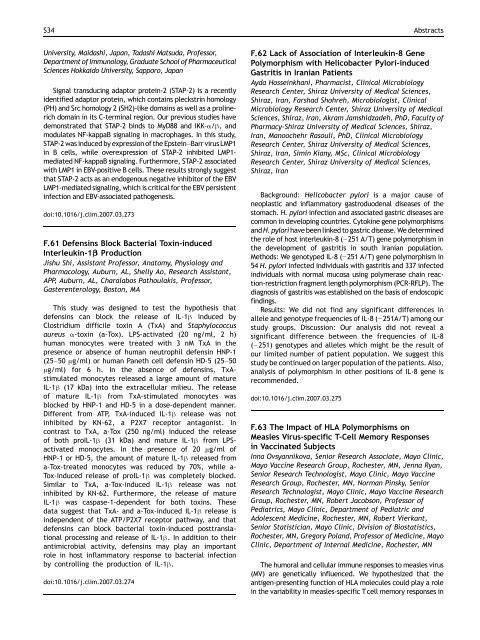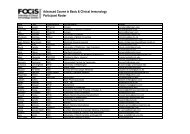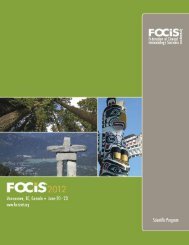Oral Presentations - Federation of Clinical Immunology Societies
Oral Presentations - Federation of Clinical Immunology Societies
Oral Presentations - Federation of Clinical Immunology Societies
Create successful ePaper yourself
Turn your PDF publications into a flip-book with our unique Google optimized e-Paper software.
S34 Abstracts<br />
University, Maidashi, Japan, Tadashi Matsuda, Pr<strong>of</strong>essor,<br />
Department <strong>of</strong> <strong>Immunology</strong>, Graduate School <strong>of</strong> Pharmaceutical<br />
Sciences Hokkaido University, Sapporo, Japan<br />
Signal transducing adaptor protein-2 (STAP-2) is a recently<br />
identified adaptor protein, which contains pleckstrin homology<br />
(PH) and Src homology 2 (SH2)-like domains as well as a prolinerich<br />
domain in its C-terminal region. Our previous studies have<br />
demonstrated that STAP-2 binds to MyD88 and IKK-α/β, and<br />
modulates NF-kappaB signaling in macrophages. In this study,<br />
STAP-2 was induced by expression <strong>of</strong> the Epstein–Barr virus LMP1<br />
in B cells, while overexpression <strong>of</strong> STAP-2 inhibited LMP1mediated<br />
NF-kappaB signaling. Furthermore, STAP-2 associated<br />
with LMP1 in EBV-positive B cells. These results strongly suggest<br />
that STAP-2 acts as an endogenous negative inhibitor <strong>of</strong> the EBV<br />
LMP1-mediated signaling, which is critical for the EBV persistent<br />
infection and EBV-associated pathogenesis.<br />
doi:10.1016/j.clim.2007.03.273<br />
F.61 Defensins Block Bacterial Toxin-induced<br />
Interleukin-1β Production<br />
Jishu Shi, Assistant Pr<strong>of</strong>essor, Anatomy, Physiology and<br />
Pharmacology, Auburn, AL, Shelly Ao, Research Assistant,<br />
APP, Auburn, AL, Charalabos Pathoulakis, Pr<strong>of</strong>essor,<br />
Gasterenterology, Boston, MA<br />
This study was designed to test the hypothesis that<br />
defensins can block the release <strong>of</strong> IL-1β induced by<br />
Clostridium difficile toxin A (TxA) and Staphylococcus<br />
aureus α-toxin (a-Tox). LPS-activated (20 ng/ml, 2 h)<br />
human monocytes were treated with 3 nM TxA in the<br />
presence or absence <strong>of</strong> human neutrophil defensin HNP-1<br />
(25–50 μg/ml) or human Paneth cell defensin HD-5 (25–50<br />
μg/ml) for 6 h. In the absence <strong>of</strong> defensins, TxAstimulated<br />
monocytes released a large amount <strong>of</strong> mature<br />
IL-1β (17 kDa) into the extracellular milieu. The release<br />
<strong>of</strong> mature IL-1β from TxA-stimulated monocytes was<br />
blocked by HNP-1 and HD-5 in a dose-dependent manner.<br />
Different from ATP, TxA-induced IL-1β release was not<br />
inhibited by KN-62, a P2X7 receptor antagonist. In<br />
contrast to TxA, a-Tox (250 ng/ml) induced the release<br />
<strong>of</strong> both proIL-1β (31 kDa) and mature IL-1β from LPSactivated<br />
monocytes. In the presence <strong>of</strong> 20 μg/ml <strong>of</strong><br />
HNP-1 or HD-5, the amount <strong>of</strong> mature IL-1β released from<br />
a-Tox-treated monocytes was reduced by 70%, while a-<br />
Tox-induced release <strong>of</strong> proIL-1β was completely blocked.<br />
Similar to TxA, a-Tox-induced IL-1β release was not<br />
inhibited by KN-62. Furthermore, the release <strong>of</strong> mature<br />
IL-1β was caspase-1-dependent for both toxins. These<br />
data suggest that TxA- and a-Tox-induced IL-1β release is<br />
independent <strong>of</strong> the ATP/P2X7 receptor pathway, and that<br />
defensins can block bacterial toxin-induced posttranslational<br />
processing and release <strong>of</strong> IL-1β. In addition to their<br />
antimicrobial activity, defensins may play an important<br />
role in host inflammatory response to bacterial infection<br />
by controlling the production <strong>of</strong> IL-1β.<br />
doi:10.1016/j.clim.2007.03.274<br />
F.62 Lack <strong>of</strong> Association <strong>of</strong> Interleukin-8 Gene<br />
Polymorphism with Helicobacter Pylori-induced<br />
Gastritis in Iranian Patients<br />
Ayda Hosseinkhani, Pharmacist, <strong>Clinical</strong> Microbiology<br />
Research Center, Shiraz University <strong>of</strong> Medical Sciences,<br />
Shiraz, Iran, Farshad Shohreh, Microbiologist, <strong>Clinical</strong><br />
Microbiology Research Center, Shiraz University <strong>of</strong> Medical<br />
Sciences, Shiraz, Iran, Akram Jamshidzadeh, PhD, Faculty <strong>of</strong><br />
Pharmacy-Shiraz University <strong>of</strong> Medical Sciences, Shiraz,<br />
Iran, Manoochehr Rasouli, PhD, <strong>Clinical</strong> Microbiology<br />
Research Center, Shiraz University <strong>of</strong> Medical Sciences,<br />
Shiraz, Iran, Simin Kiany, MSc, <strong>Clinical</strong> Microbiology<br />
Research Center, Shiraz University <strong>of</strong> Medical Sciences,<br />
Shiraz, Iran<br />
Background: Helicobacter pylori is a major cause <strong>of</strong><br />
neoplastic and inflammatory gastroduodenal diseases <strong>of</strong> the<br />
stomach. H. pylori infection and associated gastric diseases are<br />
common in developing countries. Cytokine gene polymorphisms<br />
and H. pylori have been linked to gastric disease. We determined<br />
the role <strong>of</strong> host interleukin-8 (−251 A/T) gene polymorphism in<br />
the development <strong>of</strong> gastritis in south Iranian population.<br />
Methods: We genotyped IL-8 (−251 A/T) gene polymorphism in<br />
54 H. pylori infected individuals with gastritis and 337 infected<br />
individuals with normal mucosa using polymerase chain reaction-restriction<br />
fragment length polymorphism (PCR-RFLP). The<br />
diagnosis <strong>of</strong> gastritis was established on the basis <strong>of</strong> endoscopic<br />
findings.<br />
Results: We did not find any significant differences in<br />
allele and genotype frequencies <strong>of</strong> IL-8 (−251A/T) among our<br />
study groups. Discussion: Our analysis did not reveal a<br />
significant difference between the frequencies <strong>of</strong> IL-8<br />
(−251) genotypes and alleles which might be the result <strong>of</strong><br />
our limited number <strong>of</strong> patient population. We suggest this<br />
study be continued on larger population <strong>of</strong> the patients. Also,<br />
analysis <strong>of</strong> polymorphism in other positions <strong>of</strong> IL-8 gene is<br />
recommended.<br />
doi:10.1016/j.clim.2007.03.275<br />
F.63 The Impact <strong>of</strong> HLA Polymorphisms on<br />
Measles Virus-specific T-Cell Memory Responses<br />
in Vaccinated Subjects<br />
Inna Ovsyannikova, Senior Research Associate, Mayo Clinic,<br />
Mayo Vaccine Research Group, Rochester, MN, Jenna Ryan,<br />
Senior Research Technologist, Mayo Clinic, Mayo Vaccine<br />
Research Group, Rochester, MN, Norman Pinsky, Senior<br />
Research Technologist, Mayo Clinic, Mayo Vaccine Research<br />
Group, Rochester, MN, Robert Jacobson, Pr<strong>of</strong>essor <strong>of</strong><br />
Pediatrics, Mayo Clinic, Department <strong>of</strong> Pediatric and<br />
Adolescent Medicine, Rochester, MN, Robert Vierkant,<br />
Senior Statistician, Mayo Clinic, Division <strong>of</strong> Biostatistics,<br />
Rochester, MN, Gregory Poland, Pr<strong>of</strong>essor <strong>of</strong> Medicine, Mayo<br />
Clinic, Department <strong>of</strong> Internal Medicine, Rochester, MN<br />
The humoral and cellular immune responses to measles virus<br />
(MV) are genetically influenced. We hypothesized that the<br />
antigen-presenting function <strong>of</strong> HLA molecules could play a role<br />
in the variability in measles-specific T cell memory responses in




